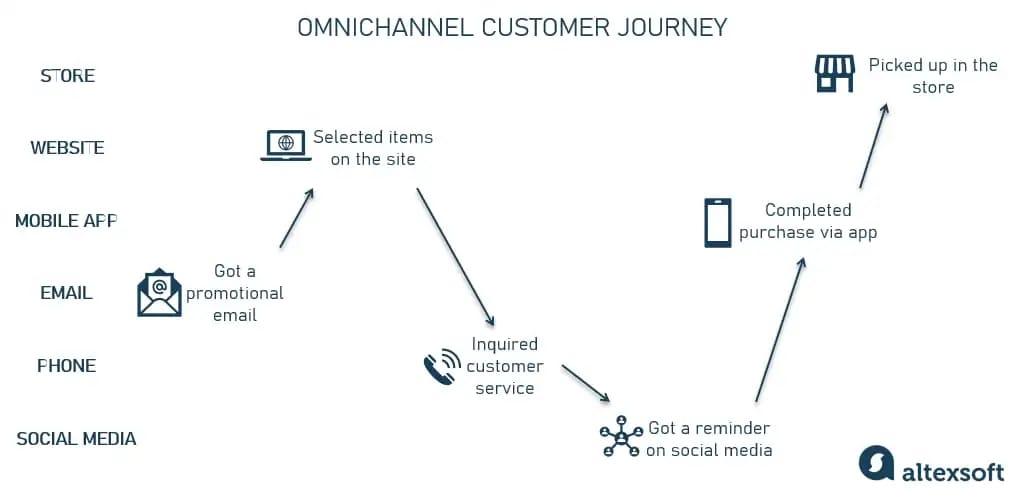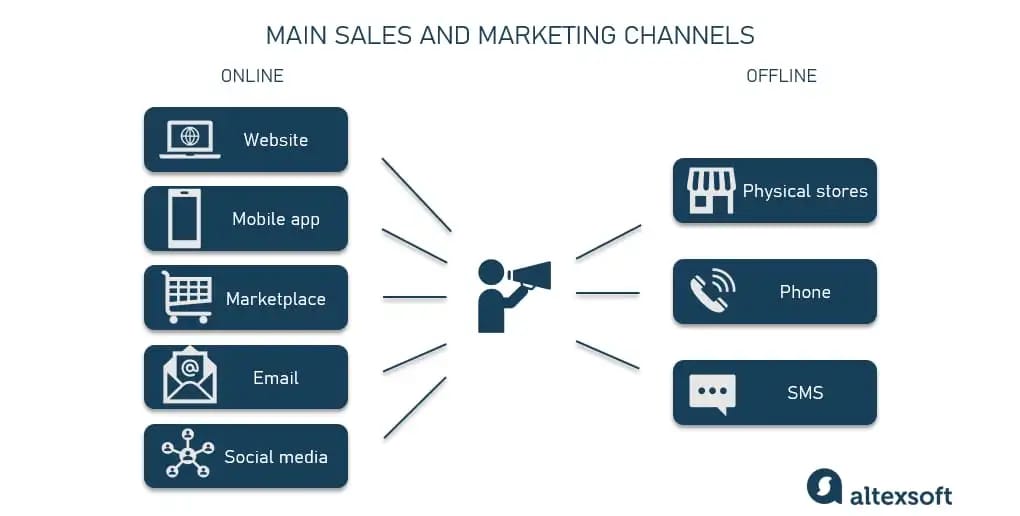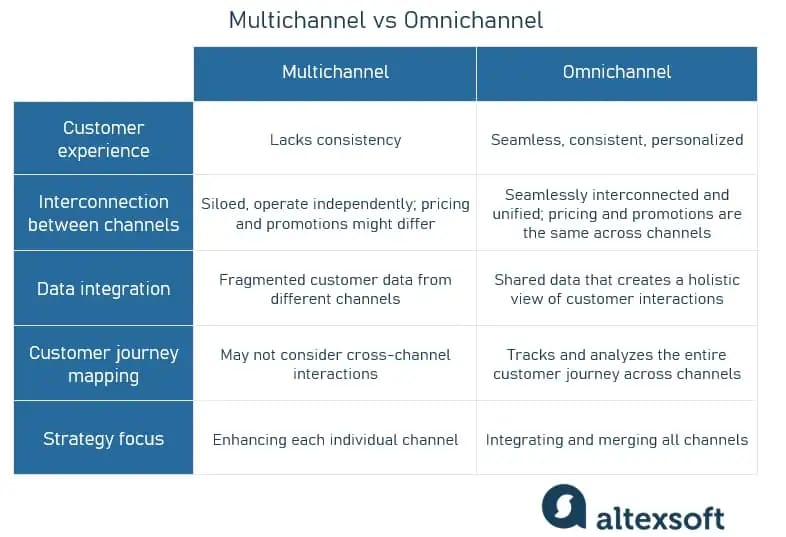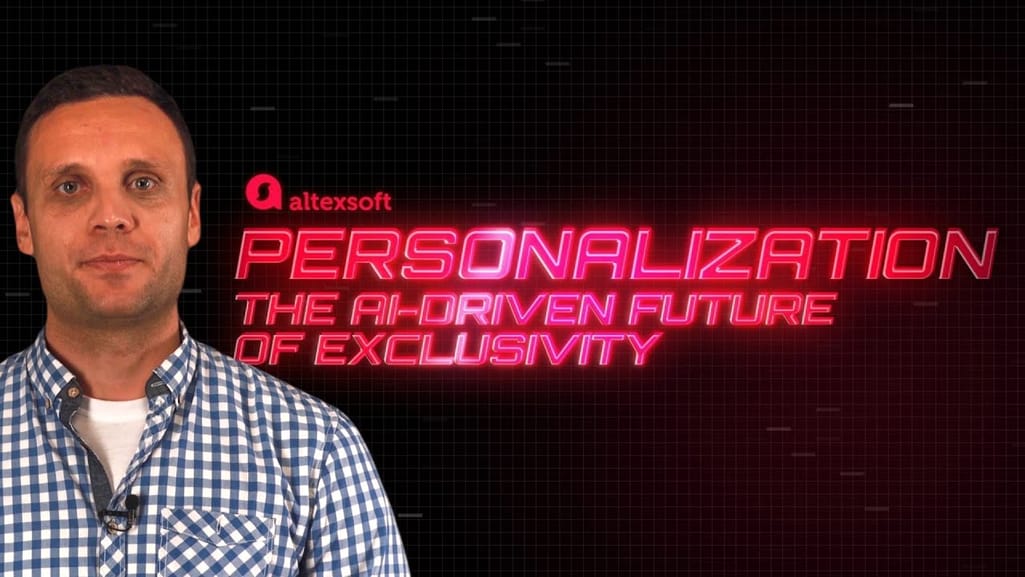In today’s world of interconnected devices, one-touch shopping apps, and AI-driven customer support, traditional marketing is not just outdated—it's obsolete. What came to replace it is an omnichannel approach, where all touchpoints are seamlessly interconnected, weaving an excellent customer experience from the ping of notification to personalized in-store interaction.
Omnichannel is a new, transformative way of connecting, engaging, and retaining your customers. So let’s talk about how you can build an effective omnichannel strategy that will boost your business development.
What is omnichannel, and how does it work?
Omnichannel refers to an approach to sales, marketing, and customer support that aims to integrate all the brand’s online and offline sales channels and provide customers with a seamless, consistent, and complementary shopping experience across all touchpoints.
An example of an omnichannel interaction scenario can comprise the following steps:
- customer gets a promotional email with a link to the brand’s website;
- chooses items online and adds them to the cart;
- consults customer support over the phone or in the chatbot about selected items, with the sales representative seeing the whole purchase history;
- receives a reminder on Facebook about the abandoned online shopping cart;
- completes checkout in the app; and
- picks up the purchase in the store.

Omnichannel interaction scenario
Various studies show that in the age of digital transformation, consumers use a mix of channels to interact with brands. Thus, 60 to 70 percent of the McKinsey survey respondents use multiple online and offline channels to research and purchase.
The digital marketing company Safari Digital states that 43 percent of users do an online search from their smartphone while in the store. The same survey reports that 78 percent of location-oriented online searches lead to a purchase in the physical store, which means brands that adopt an omnichannel approach benefit from it as they satisfy customer expectations and increase sales. As per Omnisend stats, the purchase rate of omnichannel campaigns is 287 percent higher than that of single-channel campaigns.
This and other research prove that even though an omnichannel approach requires a significant investment in technology and strategy alignment, it leads to sales growth and better long-term customer relationships.
So what are the key characteristics of an omnichannel approach?
Customer-centric – omnichannel places customers at the center, recognizing that they use multiple channels in their shopping journey and striving to make it as frictionless as possible.
Unified experience – it integrates touchpoints so that, regardless of the channel, the customer's experience feels consistent. For example, if a customer adds an item to their shopping cart on a brand's mobile app but later switches to the desktop website, that item should still be in their cart.
Data integration – omnichannel relies on a seamlessly integrated backend system to share data across all sales and marketing platforms. This ensures that customer preferences, purchase history, etc., are available regardless of the touchpoint.
Personalization – a successful omnichannel strategy often leverages personalized content and recommendations based on the integrated view of the customer across all channels.
While often discussed in the context of retail, omnichannel concepts are applied across various industries, including banking, healthcare, and more. We’ll discuss some real-world examples from different fields in one of the next sections.
Main sales and marketing channels
We’ve been constantly referring to multiple sales and marketing channels that can be leveraged in your omnichannel strategy, but what exactly are they? Let’s list them and briefly describe their value.

Main sales and marketing channels
Physical stores. Good old brick-and-mortar stores are far from dead, as they still offer buyers that priceless in-person interaction, tactile shopping experience, a convenient pickup option, and an equally convenient return service. For brands, the biggest value of offline points of sale is the wide opportunities for upselling and cross-selling.
Phone. Another old but gold offline channel, phone interactions ensure personalized communication, immediate feedback, and an opportunity to instantly address queries or concerns.
SMS. Messages are great for immediate customer reach and time-sensitive promotions or notifications.
Website. Even despite the growing popularity of mobile apps, online presence is still a must. Available 24/7, the online site increases customer reach and serves as a platform for direct sales and customer engagement. In addition, a website today is a complete business portfolio where you can share company news, awards, values, history, testimonials, and other information. It’s also a useful instrument to collect customer data for further analysis.
Mobile app. Quarterly reports by data.ai state that the mobile market is stronger than ever. The growth of mobile spending is evidence that consumers are increasingly using their smartphones to access the Internet on the go and interact with brands, so it makes sense to provide them with that opportunity.
User-friendly mobile applications offer a tailored user experience, often including handy functionality like QR scanners, loyalty programs, gamification options, or additional communication channels. Also, push notifications are a powerful marketing and customer service tool.
Marketplaces. Digital bazaars are especially important for smaller businesses as they give instant access to a vast customer base, reduced marketing costs, and potential for increased sales volume.
Email. Emails are a scalable and, importantly, measurable marketing instrument. It works well in a wide range of scenarios (personalized offers, feedback requests, general promotional campaigns, etc.).
Social media. Recent research by DataReportal shows that people spend about 2.5 hours daily on social media, which accounts for 38 percent of their online time. Brands take advantage of this trend to engage with a vast audience, build brand awareness, develop targeted advertising, and get direct customer feedback. However, for best results, you have to stay active and develop your account.
Other sales and marketing channels include various partnerships and affiliate programs. In the B2B environment, the list can also comprise e-procurement portals, video conferences, and industry events such as conferences or trade shows.
Omnichannel vs multichannel
Before we proceed to actually discuss the components of an omnichannel strategy, let’s briefly clear up the common confusion between the two similar concepts, i.e., omnichannel and multichannel.

Multichannel vs omnichannel
In both scenarios, a company uses multiple channels to reach its customers. However, as we said, in an omnichannel approach, a business ensures a seamless and consistent experience across all channels, integrating all touchpoints. In contrast, a multichannel approach implies independent usage of sales channels, thus creating a fragmented customer experience.
Multichannel is basically about being on those channels, while they often exist as totally separate silos. Because of lack of integration, cross-channel customer interactions aren’t captured, so data collected for analytics is often fragmented and incomplete. Also, a multichannel strategy is mainly focused on developing each individual channel separately, while an omnichannel strategy is geared towards exhaustively merging all the channels.
So let’s finally get deeper into the field of strategic matters.
Omnichannel strategy
An omnichannel strategy encompasses a wide range of activities businesses implement to create that seamless and integrated customer experience across multiple channels and touchpoints, both online and offline. It combines marketing, customer service, and sales to forge a unified brand identity that fosters customer loyalty and drives business growth.
Let’s unravel it piece by piece, starting with its primary goal – an omnichannel customer experience.
Omnichannel customer experience
It’s a fact that during the entire process of interaction with a brand, today’s customers continuously switch between various channels. So a successful omnichannel strategy aims at ensuring that customers can start an interaction on one channel and easily continue it on another without losing information or encountering disruptions. It involves offering the same level of service and information whether customers are online, in a physical store, or using a mobile app.
Omnichannel marketing
Omnichannel marketing is about promoting your products or services across various channels while maintaining a consistent message and brand image. Found at the core of the omnichannel strategy, it focuses on reaching customers through their preferred channels, delivering personalized content and offers, and ensuring that marketing efforts are coordinated and complementary. This may involve email marketing, social media advertising, SMS campaigns, etc.
Omnichannel customer service
Omnichannel customer service means offering customers consistent, efficient assistance across multiple communication channels. For example, if a customer begins a transaction or support request in one channel and then switches to another, the information and context are retained. This is possible due to complete system integration (CRM, inventory management software, retail tools, etc.) so that customer service staff always has the most up-to-date, comprehensive view of customer interactions.
Omnichannel personalization
Omnichannel personalization is the practice of tailoring content, product recommendations, and communication to individual customer preferences and behaviors across all channels. It involves collecting and analyzing customer data to understand their needs and preferences and using this information to create a personalized experience – within marketing, sales, and support activities alike.


Watch our expert explaining how to approach personalization and the role AI plays in it
Personalization can be based on factors like browsing history, purchase history, location, and more.
How to build an omnichannel strategy: key steps
Building an effective omnichannel strategy requires careful planning and execution (duh…). The precise algorithm will definitely vary across businesses and will depend on your industry, company size, goals, etc. However, here is the general approach you can use as rough guide to create your own strategy.
Planning, research, and technology adoption
Define your goals. What do you want to achieve with your omnichannel strategy? Goals may include increasing sales, boosting customer loyalty, improving brand awareness, or expanding into new markets. Your goals will guide your strategy and help you measure success.
Implement specialized software. Consider implementing solid CRM software and marketing automation tools to centralize data and communication. Set up automated follow-up messages and product recommendations to boost retention.
As you develop, enhance your toolkit with machine learning and AI capabilities to scrutinize available data even deeper, make more accurate predictions about customer demand, implement smart chatbots, roll out personalized campaigns, and understand market trends better.


Demand forecasting is crucial in any industry
Create an integrated IT environment. Data integration is like a thematic element running through this entire topic because this is the key to connecting all your channels and synchronizing your activities. Whatever business management software you utilize to automate your operations (e.g., ERP, eCommerce platform, order management systems, CRM, etc.), it must be able to bridge your offline and online undertakings and not let any data fall through the cracks.
By interconnecting your systems, you’ll establish seamless data exchange and ensure that customer and sales-related information is accessible and consistent across all channels. This way, you’ll be able to collect all the data you need for research and analysis that we describe further.
Understand your customer. To have a deep knowledge of your target audience, analyze customer data to identify their preferences, behaviors, and buying habits. You can gather data from various sources, including website analytics, social media insights, and customer surveys. This information will help you create customer personas and segment your audience.
Map customer journeys. Understand the various touchpoints and stages in your customer's journey. Map out how customers move between channels during their interactions with your brand. This will help you identify opportunities to provide a seamless experience and address pain points.
Select relevant channels. As an outcome of the research done in the previous steps, you’ll be able to identify the channels where your target audience is most active. This may include social media platforms, mobile apps, websites, physical stores, etc. It’s also worth researching your competitors and the market in general to get a fuller picture. This way, you’ll be able to prioritize the channels that are most likely to reach and engage your customers effectively.
Create an ecosystem. Fill in the gaps, if any, by creating and developing the missing channels. For example, if you don’t have an app, build one. Or you might discover that your audience is a heavy user of a certain social media platform (e.g., YouTube, TikTok, Instagram, etc.), so expand your presence in the most impactful channels and look for ways to deliver the best experience where your customers are.
Marketing activities adjustments
Create consistent branding. Consistency builds trust and recognition, so maintain a consistent brand image and messaging across all channels (but avoid boilerplate content). Ensure that your brand's colors, logos, tone of voice, and values are the same across your website, social media profiles, email campaigns, and in-store experience. Pay special attention to translated and localized versions of your materials.
Implement cross-channel campaigns. Develop marketing campaigns that span multiple channels. For example, you might launch a campaign that starts with a social media teaser, followed by an email with more details, and then leads to a personalized product recommendation on your website. Ensure that these campaigns are well-coordinated and consistent.
Enhance personalization. One more step forward is using customer data to personalize marketing efforts. Today, 66 percent of customers expect brands to know their unique needs. So tailor your content, product recommendations, and offers to individual preferences and behaviors. Personalization can significantly enhance the customer experience and boost conversion rates.
Offer cross-channel customer support. Make sure your customers can reach you using their preferred channels and quickly get professional answers to their queries (remember about upselling opportunities, too!).
Operational routine
Measure and analyze performance. Implement analytics/BI tools to track the performance of your omnichannel marketing efforts. Monitor KPIs such as conversion rates, customer lifetime value, customer retention, customer satisfaction, etc. Use the data to improve your strategy.
Check out our top 15 product management KPIs overview for inspiration.
Iterate and optimize. An omnichannel strategy is not static. Continuously gather feedback and insights from customers, and use this information to refine and optimize your strategy. Stay updated with industry trends and technology advancements to adapt to changing customer preferences.
Train your team. Ensure that your marketing, sales, and customer service teams realize the importance of creating an omnichannel experience, know how to use the software tools fully, and work together to execute the strategy effectively. Collaboration and communication between departments are essential to maintaining a consistent customer experience.
Ensure compliance and data security. Remember to comply with data protection regulations (e.g., GDPR, CCPA) and prioritize the security of customer data in all your omnichannel activities.
Building and executing an effective omnichannel strategy requires ongoing effort and a commitment to delivering a superior customer experience. By understanding your audience, integrating systems, and consistently delivering personalized, cross-channel experiences, you can create a strategy that drives customer engagement and business growth.
Omnichannel examples across industries
Let’s now look at some well-known brands that have already gone omnichannel and see what exactly they offer to their customers to increase their satisfaction, loyalty, and retention.
Omnichannel in retail: Sephora, Nike, Timberland
Most major retail companies are heavily investing in technology and are already reaping the benefits of providing customers with an omnichannel experience.
For example, the fast-growing beauty giant Sephora, present in 35 countries with over 2,700 stores, is well-recognized for its digital innovations. It seamlessly merges online and offline with such offerings as Facebook Live Shopping, same-day delivery, Buy Online Pick Up In Store, and Instagram Checkout. Shoppers can book in-person consultations via the app. And after they get a makeover by Sephora’s beauty advisors, they can get a log of all the products used by email. The app also includes a Virtual Artist feature that uses facial recognition technology for trying on makeup virtually and an AI-powered chatbot.
Nike also made its mobile app the “ultimate shopping companion” by enabling customers to search and reserve items in their local store, scan QR codes for product descriptions, get recommendations based on previous purchases, and unlock exclusive access to promotions and the latest products. And its Run Club app, with 100+ million users, besides being one of the most popular fitness and workout apps on the market, has created an active community of sports fans.
Timberland leverages NFC technology to digitize and enhance the in-store shopping experience. Instead of looking for a sales representative for consultation, customers can get instant information about the item (along with personalized recommendations) on the tablet they receive when they enter the store.
Omnichannel in travel: Mariott, Disney
The travel industry is very multi-faceted, including such sectors as hospitality, aviation, tours and attractions, etc. Despite the differences in operations, many companies have found a way to create an omnichannel experience for travelers.
For example, Marriott’s omnichannel strategy focuses on providing an integrated experience from booking to stay. Their mobile app serves as a virtual concierge, allowing guests to check in and out, chat with hotel staff, and even unlock their rooms. In addition, Marriott's loyalty program, Bonvoy, integrates experiences across all their hotel brands so that users can earn and redeem points seamlessly. By making services and communication accessible through various channels, Marriott ensures higher guest engagement and repeat bookings, ultimately boosting their revenue.
You can read more about smart hotels and how they create an integrated, IoT-based infrastructure in our dedicated posts.
Disney, the global entertainment corporation, also designed a multi-featured My Disney Experience app to create a cohesive experience, from planning a trip with personal recommendations from its Genie Service to booking dining, entering sites, adding purchases to the folio, and locating attractions within its parks.
Complementing the app is Disney's intelligent wearable that allows travelers to “experience next-level magic.” Paired with a smartphone and managed through the app, this smart bracelet acts as a pass, credit card, room key, ID, and more. Users can link Disney PhotoPass photos to their Disney account and interact with park characters thanks to gesture recognition technology. All this leads to enhanced guest experiences, increased time spent in the parks, and, consequently, higher spending on merchandise, food, and more.
Omnichannel in automotive: Tesla
An industry disruptor, Tesla facilitates the car buying process by aligning their offline and online strategy. It offers online interfaces, digitized points of sale, and self-service tools like the vehicle configurator – together with traditional shopping elements like in-store consultations and test drives. The results of such an approach are impressive: 33 percent higher lead-to-order conversion, 5 hours less time invested per car sold, and 40 percent less cost per car sold.
Omnichannel in finance: Bank of America
Bank of America offers a unified experience across its mobile apps, website, ATMs, and physical branches. Customers can start processes on one channel and continue on another. For example, a user can begin opening an account on the mobile app and finish in a branch. Their ATMs are also integrated with their mobile app, allowing for cardless ATM access.
The bank provides a range of user-friendly, AI-enhanced financial digital products for diverse needs: the virtual financial assistant Erica, the money transfer service Zelle, the in-app financial planner Life Plan, the CashPro app to manage business finances, and so on. As a result of such digitization, BoA reported more than 54 million active digital users across all its products (as of 2022).
Omnichannel in healthcare: Mayo Clinic
The Mayo Clinic has adopted a patient-centered omnichannel approach with its online portal that allows patients to access test results, manage appointments, view clinical notes, pay bills, and communicate with their healthcare providers. They also provide health information and tools through their app and website, ensuring consistent information across channels.
In addition, the Mayo Clinic maintains a strong presence on multiple social media platforms where it answers questions, shares patient stories, and raises awareness for better health. It also builds global patient communities with its blog. In all of these ways, the Mayo Clinic enhances patient engagement, satisfaction, and care continuity. A seamless experience across digital touchpoints can also lead to improved adherence to treatment plans and follow-ups, enhancing patient outcomes.

Maria is a curious researcher, passionate about discovering how technologies change the world. She started her career in logistics but has dedicated the last five years to exploring travel tech, large travel businesses, and product management best practices.
Want to write an article for our blog? Read our requirements and guidelines to become a contributor.

